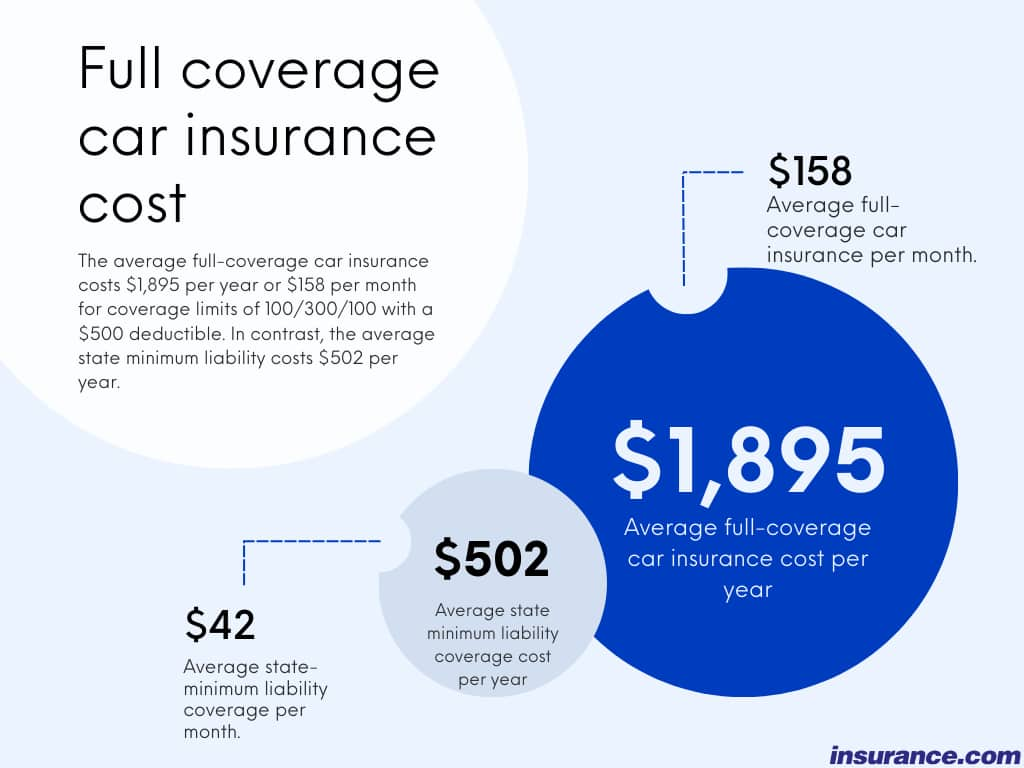- How much is full coverage car insurance by company?
- How much is full coverage car insurance in your state?
- Full coverage car insurance rates by age
- Best car insurance for full coverage
- Full coverage car insurance: Our recommendation
- Choose the right coverage using our car insurance coverage calculator
- How to get cheap full coverage car insurance
- When should you drop full coverage on your car?
- Methodology
- Full coverage car insurance cost: Frequently asked questions
How much is full coverage car insurance by company?
The average full coverage car insurance cost is $1,895 per year, or about $158 per month. That’s based on coverage of 100/300/100 ($100,000 per person, $300,000 per incident for injuries, and $100,000 for property damage.) The average cost of state minimum coverage, which offers much less coverage, is $502 annually.
Nationwide offers the best deal on full coverage car insurance. Its car insurance rates average $129 per month, or $1,548 annually. USAA offers cheaper coverage to people who are eligible.
Below you’ll find the cheapest companies for full coverage car insurance.
*USAA only provides coverage to military members, veterans and their families.
People ask
How much is full coverage insurance on a new car?
The average car insurance rates for a full coverage policy on a new car depend on the car's make and model as well as personal factors like your driving record and where you live. Our average rate is based on a 2023 Honda Accord LX.
How much is full coverage car insurance in your state?
The average cost of full coverage car insurance in the U.S. is $1,895 a year, or $158 a month. That’s based on 100/300/100 liability limits with $500 deductibles. These are averages; your rates will differ.
Maine is the cheapest state for full coverage car insurance, with an average car insurance cost of $1,175 annually. The three cheapest states for this level of coverage and their annual premiums are:
- Maine: $1,175, $720 below the national average
- New Hampshire: $1,265, $630 below the national average
- Vermont: $1,319, $576 below the national average
At the other extreme, Louisiana is the most expensive state for full coverage car insurance, with premiums that cost $2,883 annually. The three most expensive states for full coverage are:
- Louisiana: $2,883, $988 above the national average
- Florida: $2,694, $799 above the national average
- California: $2,416, $521 above the national average
Below you’ll find how much full coverage costs in each state.
| State | State minimum coverage | Full coverage (100/300/100), $500 deductible | Difference |
|---|---|---|---|
| Alaska | $398 | $1,676 | $1,278 |
| Alabama | $433 | $1,860 | $1,427 |
| Arkansas | $397 | $1,957 | $1,560 |
| Arizona | $516 | $1,812 | $1,296 |
| California | $551 | $2,416 | $1,865 |
| Colorado | $437 | $2,337 | $1,900 |
| Connecticut | $704 | $1,725 | $1,021 |
| Washington, D.C. | $558 | $2,157 | $1,599 |
| Delaware | $788 | $2,063 | $1,275 |
| Florida | $993 | $2,694 | $1,701 |
| Georgia | $577 | $1,970 | $1,393 |
| Hawaii | $396 | $1,517 | $1,121 |
| Iowa | $260 | $1,630 | $1,370 |
| Idaho | $357 | $1,428 | $1,071 |
| Illinois | $421 | $1,532 | $1,111 |
| Indiana | $417 | $1,515 | $1,098 |
| Kansas | $434 | $1,900 | $1,466 |
| Kentucky | $606 | $2,228 | $1,622 |
| Louisiana | $722 | $2,883 | $2,161 |
| Massachusetts | $511 | $1,726 | $1,215 |
| Maryland | $727 | $1,746 | $1,019 |
| Maine | $335 | $1,175 | $840 |
| Michigan | $654 | $2,352 | $1,698 |
| Minnesota | $475 | $1,911 | $1,436 |
| Missouri | $488 | $1,982 | $1,494 |
| Mississippi | $463 | $2,008 | $1,545 |
| Montana | $350 | $2,193 | $1,843 |
| North Carolina | $476 | $1,741 | $1,265 |
| North Dakota | $349 | $1,665 | $1,316 |
| Nebraska | $331 | $1,902 | $1,571 |
| New Hampshire* | $397 | $1,265 | $868 |
| New Jersey | $853 | $1,902 | $1,049 |
| New Mexico | $421 | $2,049 | $1,628 |
| Nevada | $720 | $2,060 | $1,340 |
| New York | $731 | $1,870 | $1,139 |
| Ohio | $362 | $1,417 | $1,055 |
| Oklahoma | $408 | $2,138 | $1,730 |
| Oregon | $641 | $1,678 | $1,037 |
| Pennsylvania | $375 | $1,872 | $1,497 |
| Rhode Island | $646 | $2,061 | $1,415 |
| South Carolina | $720 | $2,009 | $1,289 |
| South Dakota | $307 | $2,280 | $1,973 |
| Tennessee | $442 | $1,677 | $1,235 |
| Texas | $572 | $2,043 | $1,471 |
| Utah | $582 | $1,825 | $1,243 |
| Virginia | $428 | $1,469 | $1,041 |
| Vermont | $306 | $1,319 | $1,013 |
| Washington | $438 | $1,608 | $1,170 |
| Wisconsin | $365 | $1,664 | $1,299 |
| West Virginia | $510 | $2,005 | $1,495 |
| Wyoming | $288 | $1,758 | $1,470 |
*New Hampshire doesn’t require drivers to have car insurance, but most drivers do, and we’ve listed the cost of what is mandated if you choose to carry coverage.
Full coverage car insurance rates by age
The cost of a full coverage policy varies by age. Full coverage car insurance for new drivers is more expensive than for older drivers; at age 16, the average cost of a full coverage policy is $7,203 a year.
Take a look at the average cost of full coverage car insurance by age below.
| Age | Company | Full coverage premium |
|---|---|---|
| 16-year-old | Nationwide | $6,094 |
| 16-year-old | State Farm | $6,368 |
| 16-year-old | Geico | $6,375 |
| 16-year-old | Travelers | $6,455 |
| 16-year-old | Progressive | $9,297 |
| 16-year-old | Allstate | $9,968 |
| 16-year-old | Farmers | $11,592 |
| 16-year-old | USAA | $6,239 |
| 17-year-old | Travelers | $5,117 |
| 17-year-old | Geico | $5,431 |
| 17-year-old | Nationwide | $5,664 |
| 17-year-old | State Farm | $5,667 |
| 17-year-old | Progressive | $7,966 |
| 17-year-old | Allstate | $8,041 |
| 17-year-old | Farmers | $9,030 |
| 17-year-old | USAA | $4,494 |
| 18-year-old | Travelers | $4,296 |
| 18-year-old | Geico | $4,644 |
| 18-year-old | State Farm | $5,077 |
| 18-year-old | Nationwide | $5,173 |
| 18-year-old | Allstate | $6,871 |
| 18-year-old | Progressive | $7,037 |
| 18-year-old | Farmers | $7,903 |
| 18-year-old | USAA | $3,790 |
| 19-year-old | Travelers | $3,476 |
| 19-year-old | Geico | $3,759 |
| 19-year-old | Nationwide | $4,209 |
| 19-year-old | State Farm | $4,353 |
| 19-year-old | Progressive | $4,591 |
| 19-year-old | Farmers | $5,155 |
| 19-year-old | Allstate | $5,170 |
| 19-year-old | USAA | $3,017 |
| 20-year-old | Travelers | $3,108 |
| 20-year-old | Geico | $3,387 |
| 20-year-old | Nationwide | $3,652 |
| 20-year-old | State Farm | $3,922 |
| 20-year-old | Progressive | $4,171 |
| 20-year-old | Farmers | $4,715 |
| 20-year-old | Allstate | $4,728 |
| 20-year-old | USAA | $2,757 |
| 21-year-old | Nationwide | $2,551 |
| 21-year-old | Travelers | $2,562 |
| 21-year-old | Geico | $2,764 |
| 21-year-old | State Farm | $3,367 |
| 21-year-old | Progressive | $3,401 |
| 21-year-old | Farmers | $3,728 |
| 21-year-old | Allstate | $3,896 |
| 21-year-old | USAA | $2,179 |
| 22-year-old | Nationwide | $2,312 |
| 22-year-old | Travelers | $2,375 |
| 22-year-old | Geico | $2,508 |
| 22-year-old | Progressive | $3,109 |
| 22-year-old | State Farm | $3,111 |
| 22-year-old | Farmers | $3,418 |
| 22-year-old | Allstate | $3,604 |
| 22-year-old | USAA | $2,048 |
| 23-year-old | Nationwide | $2,182 |
| 23-year-old | Travelers | $2,231 |
| 23-year-old | Geico | $2,355 |
| 23-year-old | State Farm | $2,842 |
| 23-year-old | Progressive | $2,865 |
| 23-year-old | Farmers | $3,170 |
| 23-year-old | Allstate | $3,369 |
| 23-year-old | USAA | $1,949 |
| 24-year-old | Nationwide | $2,085 |
| 24-year-old | Travelers | $2,107 |
| 24-year-old | Geico | $2,222 |
| 24-year-old | State Farm | $2,652 |
| 24-year-old | Progressive | $2,677 |
| 24-year-old | Farmers | $3,031 |
| 24-year-old | Allstate | $3,188 |
| 24-year-old | USAA | $1,864 |
| 25-year-old | Nationwide | $1,831 |
| 25-year-old | Travelers | $1,854 |
| 25-year-old | Geico | $2,034 |
| 25-year-old | State Farm | $2,336 |
| 25-year-old | Progressive | $2,369 |
| 25-year-old | Farmers | $2,646 |
| 25-year-old | Allstate | $2,911 |
| 25-year-old | USAA | $1,749 |
| 30-year-old | Nationwide | $1,626 |
| 30-year-old | Travelers | $1,752 |
| 30-year-old | Geico | $1,829 |
| 30-year-old | State Farm | $2,055 |
| 30-year-old | Progressive | $2,182 |
| 30-year-old | Farmers | $2,456 |
| 30-year-old | Allstate | $2,626 |
| 30-year-old | USAA | $1,503 |
| 35-year-old | Nationwide | $1,593 |
| 35-year-old | Travelers | $1,708 |
| 35-year-old | Geico | $1,791 |
| 35-year-old | State Farm | $2,003 |
| 35-year-old | Progressive | $2,107 |
| 35-year-old | Farmers | $2,399 |
| 35-year-old | Allstate | $2,539 |
| 35-year-old | USAA | $1,432 |
| 40-year-old | Nationwide | $1,548 |
| 40-year-old | Travelers | $1,606 |
| 40-year-old | Geico | $1,763 |
| 40-year-old | State Farm | $1,984 |
| 40-year-old | Progressive | $1,998 |
| 40-year-old | Farmers | $2,387 |
| 40-year-old | Allstate | $2,509 |
| 40-year-old | USAA | $1,381 |
| 45-year-old | Nationwide | $1,496 |
| 45-year-old | Travelers | $1,577 |
| 45-year-old | Geico | $1,762 |
| 45-year-old | State Farm | $1,958 |
| 45-year-old | Progressive | $1,986 |
| 45-year-old | Farmers | $2,342 |
| 45-year-old | Allstate | $2,483 |
| 45-year-old | USAA | $1,341 |
| 50-year-old | Nationwide | $1,438 |
| 50-year-old | Travelers | $1,544 |
| 50-year-old | Geico | $1,698 |
| 50-year-old | Progressive | $1,851 |
| 50-year-old | State Farm | $1,909 |
| 50-year-old | Farmers | $2,233 |
| 50-year-old | Allstate | $2,380 |
| 50-year-old | USAA | $1,298 |
| 55-year-old | Nationwide | $1,380 |
| 55-year-old | Travelers | $1,441 |
| 55-year-old | Geico | $1,670 |
| 55-year-old | Progressive | $1,793 |
| 55-year-old | State Farm | $1,838 |
| 55-year-old | Farmers | $2,152 |
| 55-year-old | Allstate | $2,314 |
| 55-year-old | USAA | $1,274 |
| 60-year-old | Nationwide | $1,351 |
| 60-year-old | Travelers | $1,440 |
| 60-year-old | Geico | $1,664 |
| 60-year-old | Progressive | $1,790 |
| 60-year-old | State Farm | $1,794 |
| 60-year-old | Farmers | $2,083 |
| 60-year-old | Allstate | $2,298 |
| 60-year-old | USAA | $1,266 |
| 65-year-old | Nationwide | $1,372 |
| 65-year-old | Travelers | $1,471 |
| 65-year-old | Geico | $1,662 |
| 65-year-old | State Farm | $1,765 |
| 65-year-old | Progressive | $1,836 |
| 65-year-old | Farmers | $2,144 |
| 65-year-old | Allstate | $2,352 |
| 65-year-old | USAA | $1,290 |
| 70-year-old | Nationwide | $1,439 |
| 70-year-old | Travelers | $1,564 |
| 70-year-old | Geico | $1,770 |
| 70-year-old | State Farm | $1,838 |
| 70-year-old | Progressive | $1,977 |
| 70-year-old | Farmers | $2,295 |
| 70-year-old | Allstate | $2,430 |
| 70-year-old | USAA | $1,378 |
| 75-year-old | Nationwide | $1,557 |
| 75-year-old | Travelers | $1,735 |
| 75-year-old | Geico | $1,931 |
| 75-year-old | State Farm | $1,971 |
| 75-year-old | Progressive | $2,189 |
| 75-year-old | Farmers | $2,434 |
| 75-year-old | Allstate | $2,647 |
| 75-year-old | USAA | $1,533 |
Best car insurance for full coverage
Erie is the best full coverage car insurance company, followed by Auto-Owners and Travelers, according to our data. The insurer earned a 4.67 overall Insurance.com score. Auto-Owners and Travelers had scores of 4.65 and 4.62, respectively.
Below is a full list of the top insurance companies for full coverage based on price, NAIC complaint ratio, customer satisfaction and AM Best financial ratings. The total Insurance.com score is calculated out of five using these factors.
| Company | Overall rating | Average premium | Customer Satisfaction | AM Best | NAIC |
|---|---|---|---|---|---|
| Erie | 4.67 | 5.00 | 4.43 | A+ | 0.61 |
| Auto-Owners | 4.65 | 4.74 | 3.97 | A++ | 0.5 |
| Travelers | 4.62 | 4.62 | 4.00 | A++ | 0.49 |
| Nationwide | 4.33 | 4.76 | 4.06 | A | 0.64 |
| Auto Club Group (AAA) | 4.29 | 4.51 | 3.75 | A+ | 0.77 |
| State Farm | 4.27 | 3.23 | 4.24 | A++ | 0.7 |
| Geico | 4.20 | 3.99 | 4.07 | A++ | 0.91 |
| Progressive | 4.14 | 3.15 | 3.91 | A+ | 0.65 |
| American Family | 4.01 | 4.22 | 4.32 | A | 1.1 |
| Amica | 3.93 | 2.37 | 3.76 | A+ | 0.61 |
| Allstate | 3.78 | 1.32 | 4.04 | A+ | 0.65 |
| Farmers | 3.69 | 1.76 | 4.12 | A | 0.8 |
| Mercury | 3.64 | 2.02 | 3.95 | A | 0.84 |
| CSAA Insurance Group (AAA) | 3.50 | 1.00 | 4.05 | A | 0.75 |
| Auto Club of Southern California (AAA) | 3.30 | 2.07 | 4.15 | A- | 2.21 |
In our rankings, full coverage includes liability limits of 100/300/100 and $500 deductibles.
People ask
Which company has the cheapest full coverage car insurance?
Nationwide has the cheapest full coverage auto insurance rates according to our data, but rates are based on a lot of factors; the cheapest full coverage car insurance companies in your area will differ, as will the cheapest for your particular situation.
Full coverage car insurance: Our recommendation
Full coverage car insurance is more expensive than liability-only, but it's the right choice for a lot of people.
You should pay extra for full coverage if:
- You have a loan or lease on your car (it will be required)
- You can't afford to repair or replace your car out of pocket
- You have a newer car that would be expensive to repair or replace
- You simply want peace of mind
You can save the money and buy liability-only if:
- You own your car outright
- You have an older, low-value car
- You have the savings to replace or repair your car
Choose the right coverage using our car insurance coverage calculator
Use our online car insurance calculator to get a personal recommendation for what kind of car insurance coverage you should buy and what deductibles to consider.
How to get cheap full coverage car insurance
The best way to find the cheapest full-coverage car insurance is to shop around and compare quotes. Insurance companies rate risk differently, which can result in dramatic differences in premiumThe payment required for an insurance policy to remain in force. Auto insurance premiums are quoted for either 6-month or annual policy periods. quotes. In addition to shopping around, here are a few tips for getting cheaper full coverage car insurance:
- Raise your deductible. A higher deductible is the easiest way to get lower rates, but make sure you can afford it if you need to pay it.
- Bundle your coverage. You can save on your car and home or renters insurance when you buy from the same company.
- Ask about discounts. There are dozens of possible car insurance discounts available, so make sure you’re getting everything you qualify for.
When should you drop full coverage on your car?
While there is no specific time at which you can or should drop full coverage, there are a few ways to decide when to drop full coverage.
First, if your loan is paid off and you feel comfortable covering the cost of repairs or replacement after an accident, you may want to drop your comprehensive and collision coverages.
A car's value drops with each passing year, and so do the insurance premiums. At a certain point, most drivers would choose to accept the risk and bank the collision and comprehensive premiums because they would be unlikely to find a reliable replacement with the insurance payout.
Consider how much you are paying for the additional coverage and how much your car is worth. Putting that extra money aside may be the wiser choice. If you don’t have an accident, it stays in your pocket. If you do, hopefully, you’ve saved enough to cover it.
Methodology
Insurance.com commissioned 2023 full coverage insurance rates from Quadrant Data Services for coverage of 100/300/100 with $500 deductibles. Rates were fielded from multiple companies in ZIP codes across the country. Rates are based on a 40-year-old male driver with a clean record, driving a 2023 Honda Accord LX. The content is updated for 2025.
Full coverage car insurance cost: Frequently asked questions
How much is full coverage insurance on a used car?
As with a new car, the cost of full coverage auto insurance depends on the year, make and model as well as personal factors.
How much is full coverage insurance a month?
The monthly cost of a full coverage policy varies, but based on the annual national average, the monthly cost would be $158.
Do you have to have full coverage insurance when financing a car?
In almost all cases, the answer to this question is yes. If you are financing your vehicle, your lender will require that you carry minimum full coverage to protect its investment in your vehicle.
Is full coverage car insurance worth it?
As with all insurance, full coverage is worth it if you need to use it. If you can't afford to repair or replace your car, full coverage car insurance is worth having.







